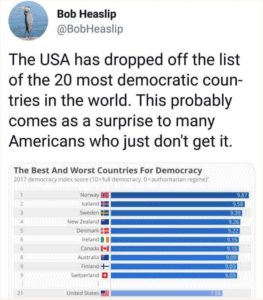A well-shared post on the Facebook page for The Christian Left shows a chart titled “The Best and Worst Countries for Democracy” with a description indicating it demonstrates that the United States has fallen off the top 20 best countries.
The chart was taken from the Economist magazine’s annual Democracy Index report. Although no single body is in charge of officially ranking world democracies, the Economist Intelligence Unit (EIU), “the research and analysis division of The Economist Group,” has issued such a ranking in 2006, 2008, and every year since 2010. The group uses multiple factors to assign each country a single score, which is used to rank countries comparatively by their level of democracy as well as classify them in categories ranging from “full democracy” to “authoritarian regime”:
The Economist Intelligence Unit’s Democracy Index is based […]
1 Comment
Wednesday, January 16th, 2019
Eoin Higgins, - The Intercept
Stephan: I am amazed that this shut down has not brought at least hundreds of thousands of Americans into the streets, filling the Mall in D.C., for instance, and creating enough citizen noise to force the Republican Senate to act.
If the Congress was a functioning body the Democratically-controlled House would pass a bill to fund the government, send it to the Senate which would also pass it, send it to the president, who would veto it, and send it back, and 67 senators would vote to override the veto -- 49 Democrats and 18 Republicans. And bingo the government would reopen. That is the way the Founders designed our system of government to work. But the Republican cult has blocked that from happening because they don't give a rat's ass for ordinary Americans. You're going to lose your house, you say? You can't afford the medications for your child's illness? Well, boo hoo, Mitch McConnell answers. I don't know how this could be made any clearer.

Cheryl Monroe, right, a Food and Drug Administration employee, and Bertrice Sanders, a Social Security Administration employee, rally to call for an end to the partial government shutdown in Detroit on Jan. 10, 2019.
Credit: Paul Sancya/AP
The Government Shutdown is into its fourth week with no end in sight. President Donald Trump started the crisis on December 22 by refusing to sign a funding bill unless it contained money for his southern border wall.
A wide range of interests across the economic spectrum are jeopardized. But not all interests are suffering equally: Wealthier and more powerful interest groups have been granted preference by the government.
Over Christmas, the shutdown threatened to stop the Federal Emergency Management Agency, or FEMA, from issuing flood insurance certificates. According to federal law, FEMA must provide flood insurance certifications before banks may issue federally backed mortgages to prospective homeowners living in federally designated floodplains — even in areas that FEMA has determined should not be built on due to high risk of flooding. The National Flood Insurance […]
1 Comment
Wednesday, January 16th, 2019
Courtenay Brown and Andrew Freedman, - Axios
Stephan: This story of California's PG&E, and its possible bankruptcy may not seem like a national story, but it is. As climate change exerts an ever-growing influence on weather events, the entire national power grid is going to be repeatedly damaged, and this story will play out again and again. Personally, this reality, plus the rise of non-carbon power generation I think is going to combine to make the grid out-dated, and too expensive to maintain. But how that happens, and what happens to the corporations that profit from the grid, and the workers that are employed by those corporations is unclear, as is its impact on the larger economy. Remember Kodak? Remember harness makers, or sailing ships for cargo? Things change and unless we prepare for the change it is always wrenching.

Illustration: Rebecca Zisser/Axios
A battle between California politicians and PG&E, the state’s largest utility, is being waged over who should have to pay the price of wildfire damage in recent years.
Why it matters: Companies are being forced to deal with the consequences of a changing climate, which is leading to more frequent and destructive wildfires and other types of disasters than ever before. PG&E’s situation is a warning to other power companies and businesses around the country.
The big picture: Last year was the worst wildfire season in California’s history.
- The Camp Fire, which destroyed the town of Paradise, was the costliest catastrophe worldwide, with $16.5 billion in damages, per reinsurance company Munich Re.
PG&E could be on the hook for billions of dollars in liability costs related to last year and the prior year’s wildfires, far more than its insurance would cover. The Camp Fire alone killed at least 86, and may have been triggered by a spark from PG&E’s power lines.
The mounting […]
1 Comment
Wednesday, January 16th, 2019
Tara Lohan, - Reader Supported News
Stephan: I have covered the story of America's declining underground aquifers several times over the years because I see this as a civilization-altering reality that was getting almost no attention in media, or from the government. Here is the latest.
 We’re living beyond our means when it comes to groundwater. That’s probably not news to everyone, but new research suggests that, deep underground in a number of key aquifers in some parts of the U.S., we may have much less water than previously thought.
We’re living beyond our means when it comes to groundwater. That’s probably not news to everyone, but new research suggests that, deep underground in a number of key aquifers in some parts of the U.S., we may have much less water than previously thought.
“We found that the average depth of water resources across the country was about half of what people had previously estimated,” said Jennifer McIntosh, a distinguished scholar and professor of hydrology and atmospheric sciences at the University of Arizona.
McIntosh and her colleagues—who published a new study about these aquifers in November in Environmental Research Letters—took a different approach to assessing groundwater than other research, which has used satellites to measure changes in groundwater storage. For example, a 2015 study looked at 37 major aquifers across the world and found some were being depleted faster than they were being replenished, including in California’s agriculturally intensive Central Valley.
McIntosh says those previous studies revealed a lot about how we’re depleting water resources from the top down through extraction, such as pumping […]
1 Comment




 Claim
Claim

 We’re living beyond our means when it comes to groundwater. That’s probably not news to everyone, but new research suggests that, deep underground in a number of key aquifers in some parts of the U.S., we may have much less water than previously thought.
We’re living beyond our means when it comes to groundwater. That’s probably not news to everyone, but new research suggests that, deep underground in a number of key aquifers in some parts of the U.S., we may have much less water than previously thought.








